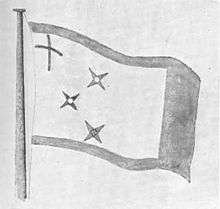Flags of the Kīngitanga
The Kīngitanga, also known as the Māori King Movement, is an indigenous New Zealand elected monarchy established by the Tainui and other iwi in 1858 in an attempt to unify Māori tribes against encroachment on their territory by British settlers.
It has used many flags since its founding, including some similar to British naval ensigns.
| Flag | Date | Use | Description |
|---|---|---|---|
 | 1858 | Flag of the United Tribes of New Zealand | The amended flag of the United Tribes of New Zealand, New Zealand's first flag, gazetted in 1835 and based on the design selected in 1834. This flag was said to have been flown at the coronation of Pōtatau Te Wherowhero in 1858. Te Wherowhero and other North Island chiefs had been signatories to the Declaration of Independence of New Zealand in the late 1830s.[1] |
 | 1858-? | Potatau era Kīngitanga flag | The flag hoisted at Ngāruawāhia on the proclamation of Pōtatau Te Wherowhero as Māori King, drawn in 1863. It depicts some of the stars of the Southern Cross, as well as a cross in the upper left canton. |
 | 1858–1860 | Potatau Hei Kingi flag | A flag used during the reign of Pōtatau Te Wherowhero, the first Māori king. This flag depicts a white cross as a symbol of Christianity on top of a red background, which symbolizes mana or prestige in Māori culture. The lower right canton is colored white and is inscribed with the words "POTATAU HEI KINGI". |
 | ?-present | Standard of Dame Te Atairangikaahu, modern Kīngitanga flag | A flag used during the reign of Dame Te Atairangikaahu (reign from 1966–2006). It is still popularly used today. |
See also
References
- ↑ The drawing of the United Tribes Ensign sent by Governor Bourke to King William IV, retrieved 2009-07-15. This design was amended when the flag was officially gazetted, with the eight-pointed stars replaced with five-pointed stars, and the black fimbriation replaced with white.
This article is issued from Wikipedia - version of the 8/9/2016. The text is available under the Creative Commons Attribution/Share Alike but additional terms may apply for the media files.